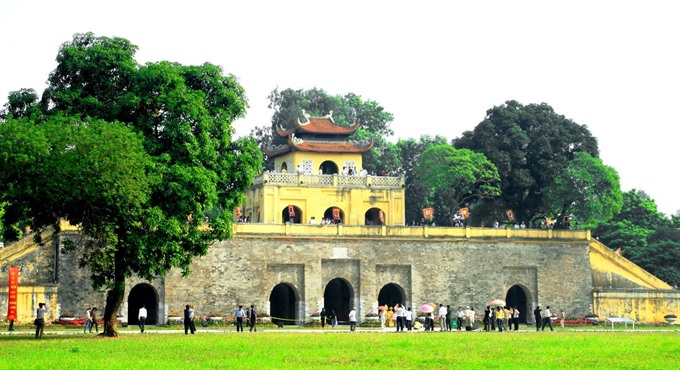Viet Nam News
HA NOI — Researchers and agencies are planning to restore two bomb shelters in Ha Noi’s Thang Long Imperial Complex. The sites, used during the anti-American war, will then be open to the public.
Prof Nguyen Van Huy, former director of Viet Nam Museum of Ethnology, said examinations have been conducted on the shelters, revealing valuable information.
“The shelters are important relics, providing historical evidence about the war,” he said. “We should do serious research and organise exhibitions, link the two shelters with other revolutionary relic sites to set up an education tour for students.”
Tran Thi Mai, a former official from the Department of Cryptography, recalled her time working in the bomb shelters.
“I transcribed orders of President Ho Chi Minh and other leaders like Le Duan, Pham Van Dong and Vo Nguyen Giap into code to send to the south for the Mau Than Tet Offensive in 1968 and campaign to liberate the south in 1975,” she said.
 |
| Capital attraction: Doan Mon Gate at Thang Long Imperial Citadel site. — VNA/VNS File Photo |
Tran Viet Anh, director of Thang Long – Ha Noi Heritage Conservation Centre, said revolutionary relics like the shelters are part of the Thang Long Imperial complex’s recognition as a World Cultural Heritage Site by UNESCO.
“Research is necessary and help us propose the development of the site,” he said.
The shelters, named No 59 and No 66, were built north of Kinh Thien Palace, which used to host the Politburo and Defence Ministry during the most fierce fighting of the anti-American war between 1965 and 1973.
Army Major Nguyen Van Khoi, another former officer from the department, remembers that Shelter No 66 is around 7m in depth, divided into two rooms. It has two doors – one facing west and the other facing south.
The centre has worked with the Ministry of Defence and the Department of Cryptography to meet people who used to work inside the shelters as well as collect memorabilia. However, they have not yet gathered many items for display.
“The shelters were closed a long time ago, so it’s quite difficult to get all of the objects back,” said Anh.
 |
| Exploring: Visitors at the entrance of shelter No 66 at Thang Long Imperial citadel. — VNA/VNS Photo |
Researcher Tran Duc Cuong, chairman of the Viet Nam Historical Science Association, said the most important thing is preserving and developing the relics involved in wartime Ha Noi, including the two shelters.
“There are very few sites with the same importance as the shelters here in the heart of the capital,” he said.
The Thang Long Imperial Citadel was first built during the Ly Dynasty (1010) and then expanded by the Tran (1225-1400), Le (1427-1527) and finally the Nguyen Dynasty (1802-1945). It remained the seat of the Vietnamese court until 1810, when the Nguyen Dynasty moved the capital to Hue.
The royal palaces and most of the structures were in varying states of disrepair by the late 19th century with the upheaval of the French conquest of Ha Noi. By the 20th century many of the remaining structures were torn down. Only in the 21st century were the ruins of Thang Long Imperial City systematically excavated.
The central area of the citadel complex was recognised as a UNESCO World Heritage Site in 2010. — VNS